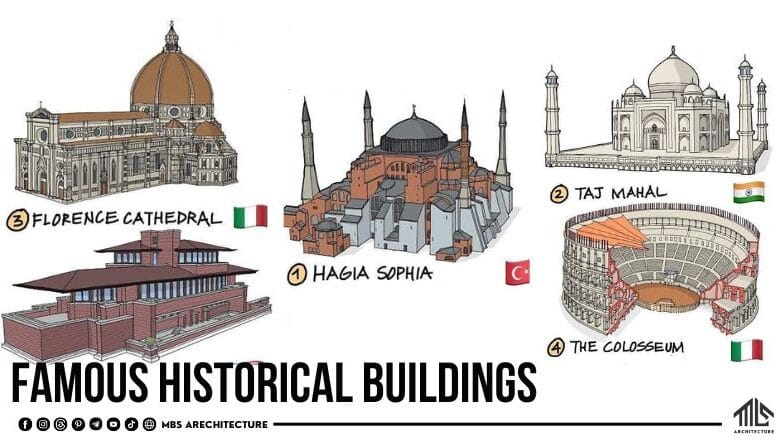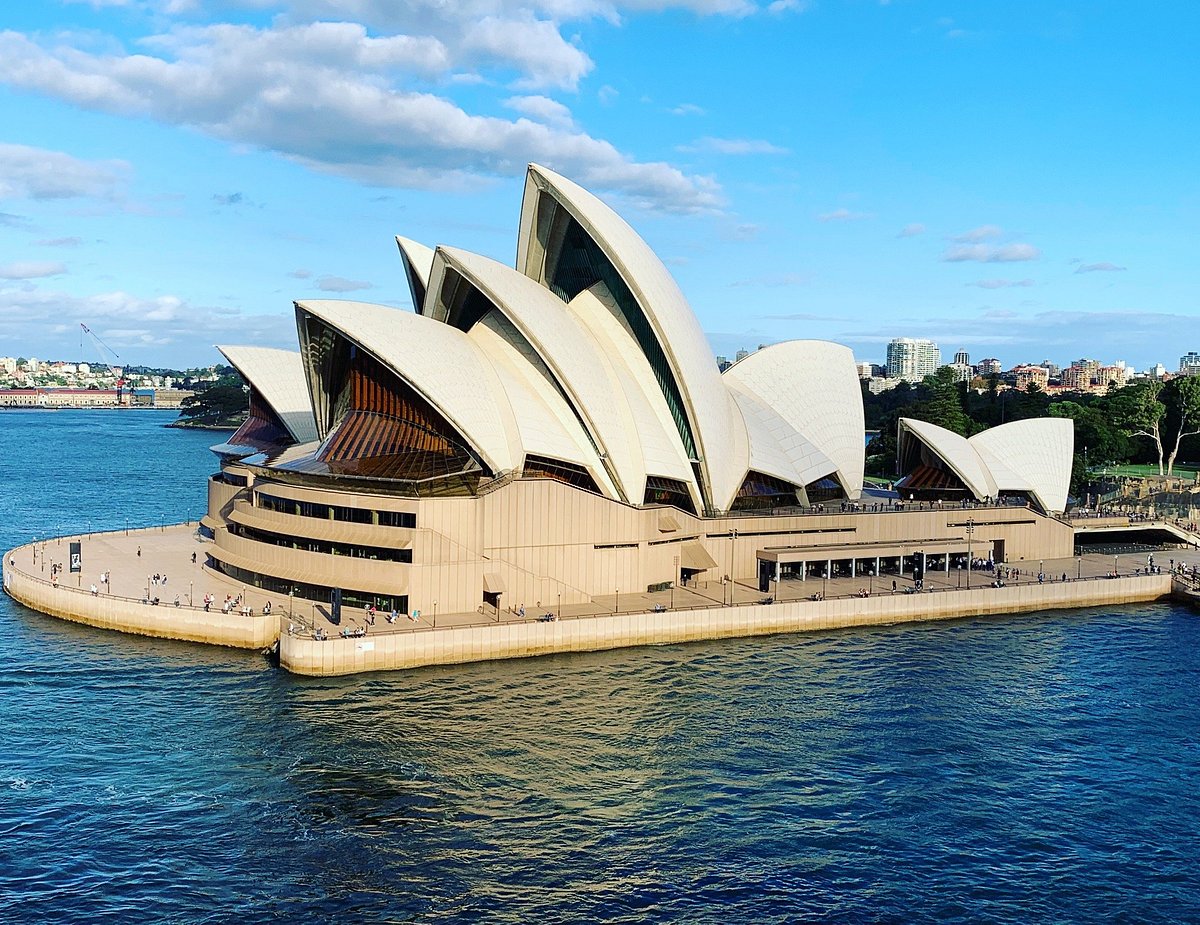
6 Famous Historical Buildings: Icons of Architecture Across the World
Famous Historical Buildings represent the creativity, engineering skill, and cultural identity of past civilizations. Landmarks like the Taj Mahal, the Great Wall of China, the Pyramids of Giza, and the Colosseum showcase architectural innovation and the historical contexts that shaped them. These structures offer insight into evolving building techniques, artistic traditions, and the cultural values of their time. Preserving and studying these Famous Historical Buildings is essential for understanding global heritage and the diverse stories that have influenced modern architecture.
1. Hagia Sophia, Turkey

Hagia Sophia, located in Istanbul, Turkey, is a remarkable structure that has withstood the test of time. Initially constructed as a Christian basilica in 537 AD during the Byzantine Empire, it was later converted into a mosque after the Ottoman conquest in 1453 and is now a museum (and recently re-designated as a mosque again in 2020).
What makes Hagia Sophia so extraordinary is its innovative dome structure, which was an architectural achievement of its time, creating a vast open space inside. The central dome is supported by pendentives, an engineering breakthrough that allowed for the large dome to sit on a square base. Hagia Sophia’s interior is adorned with stunning mosaics and intricate artwork, blending Christian and Islamic influences. It remains one of the most visited and celebrated architectural masterpieces in the world.
2. Taj Mahal, India
/https://tf-cmsv2-smithsonianmag-media.s3.amazonaws.com/filer/b6/30/b630b48b-7344-4661-9264-186b70531bdc/istock-478831658.jpg)
The Taj Mahal, located in Agra, India, is one of the most iconic symbols of love in the world. Built by Emperor Shah Jahan in memory of his wife Mumtaz Mahal, this white marble mausoleum was completed in 1643 after more than 20 years of construction. The building is a UNESCO World Heritage Site and is considered one of the New Seven Wonders of the World.
The Taj Mahal’s architectural style is a blend of Mughal, Persian, and Islamic influences. Its symmetry, the intricate floral motifs inlaid with precious stones, and the large reflecting pool in front of the main building are key features that make it a masterpiece. The enormous dome, flanked by four slender minarets, and the use of white marble, give the Taj Mahal its ethereal beauty, especially when bathed in the light of sunrise or sunset.
3. Florence Cathedral, Italy

The Florence Cathedral, also known as the Cathedral Santa Maria del Fiore, is the centerpiece of the historic city of Florence, Italy. Its construction began in 1296 and took over 140 years to complete. The cathedral is renowned for its Renaissance architecture, particularly its massive dome engineered by Filippo Brunelleschi, which was an architectural feat during the 15th century.
The cathedral’s facade is adorned with poly-chrome marble in shades of green, pink, and white, making it an instantly recognizable symbol of Florence. Brunelleschi’s dome, with its double-shell construction, was the largest in the world at the time of its completion and remains one of the most influential architectural innovations. The dome’s interior is decorated with stunning frescoes depicting the Last Judgment, adding to the grandeur of this iconic religious structure.
4. The Colosseum, Italy

The Colosseum in Rome, Italy, is one of the greatest architectural achievements of ancient Rome. This massive amphitheater, completed in 80 AD, could hold up to 50,000 spectators and was used for gladiatorial contests, public spectacles, and other forms of entertainment.
The structure’s oval shape, tiered seating, and complex system of vaults and corridors exemplify Roman engineering prowess. The Colosseum’s exterior features three levels of arches, each adorned with columns of different orders (Doric, Ionic, and Corinthian), creating a sense of harmony and grandeur. Despite being partially damaged over the centuries due to earthquakes and stone robbers, the Colosseum remains a symbol of the ancient Roman Empire and is one of the most visited tourist attractions in the world.
5. Robie House, United States

The Robie House, designed by American architect Frank Lloyd Wright, is a landmark of modern architecture. Located in Chicago, Illinois, it was completed in 1910 and is one of the finest examples of Wright’s Prairie School style. This architectural movement was heavily influenced by the flat, expansive landscape of the American Midwest and sought to integrate buildings with their natural surroundings.
The Robie House features long horizontal lines, open interior spaces, and overhanging eaves. The use of natural materials like brick and wood further enhances its connection to the environment. Wright’s design philosophy emphasized simplicity, functionality, and harmony with nature, all of which are embodied in the Robie House. The building is now recognized as a National Historic Landmark and is considered a precursor to modern architectural design principles.
6. Sydney Opera House, Australia

The Sydney Opera House is one of the most recognizable modern architectural landmarks in the world. Located on the waterfront of Sydney, Australia, it was designed by Danish architect Jørn Utzon and officially opened in 1973. The building’s unique design, featuring a series of sail-like shells, has made it a symbol of both Sydney and Australia.
The Opera House is a masterful blend of architecture and engineering. Its bold design pushed the boundaries of what was possible at the time, with its complex roof structure supported by a series of pre-cast concrete “shells.” Inside, the Opera House houses multiple performance venues, including a concert hall and theaters, making it a hub of cultural activity. The building’s integration with its waterfront location enhances its visual appeal, particularly against the backdrop of the Sydney Harbour Bridge.
These six buildings each represent a unique period, style, and cultural significance in the history of architecture. From the ancient Roman engineering of the Colosseum to the modernist innovation of the Sydney Opera House, these structures not only serve functional purposes but also stand as lasting symbols of human ingenuity and artistic expression.
As these landmarks continue to attract millions of visitors from around the globe, they remind us of the power of architecture to transcend time and connect us with different cultures, histories, and ideas. Whether through grand religious edifices, innovative modern designs, or ancient arenas, architecture remains a fundamental expression of human creativity.
FAQs
What architectural style is the Taj Mahal?
The Taj Mahal is a fine example of Mughal architecture, which blends elements from Islamic, Persian, Ottoman, and Indian architectural styles.
How long did it take to build the Florence Cathedral’s dome?
It took 16 years (from 1420 to 1436) to build the dome of the Florence Cathedral, designed by Filippo Brunelleschi.
What is the significance of the Robie House in architectural history?
The Robie House is significant for its role in the development of modern architecture. Frank Lloyd Wright’s innovative design helped shape the Prairie School movement and influenced the evolution of modernist architecture.
What makes the Sydney Opera House an architectural marvel?
The Sydney Opera House is an architectural marvel due to its bold, innovative design featuring a series of sail-like shells.The building’s unique form pushed the limits of engineering and became a symbol of modern architecture.

